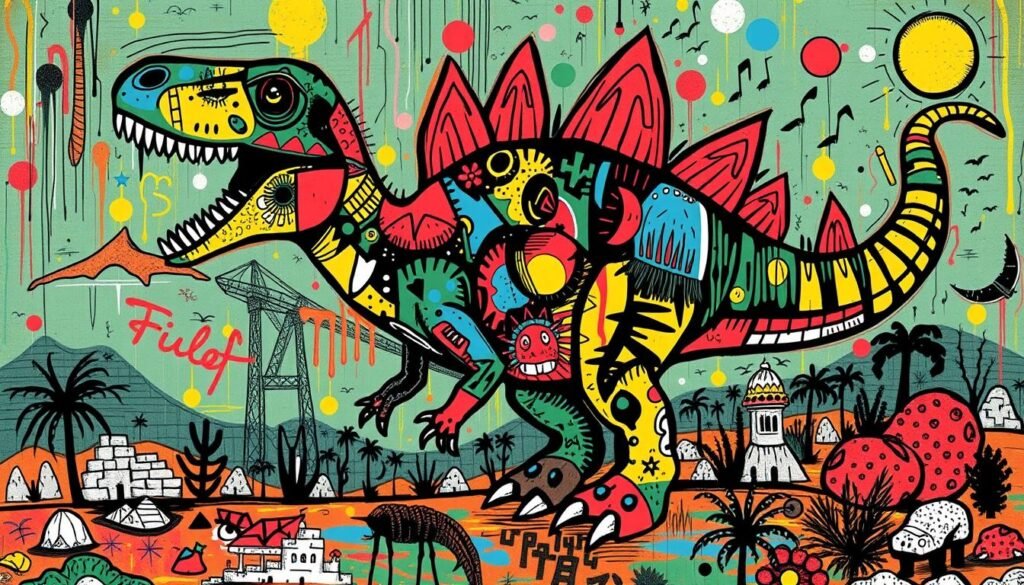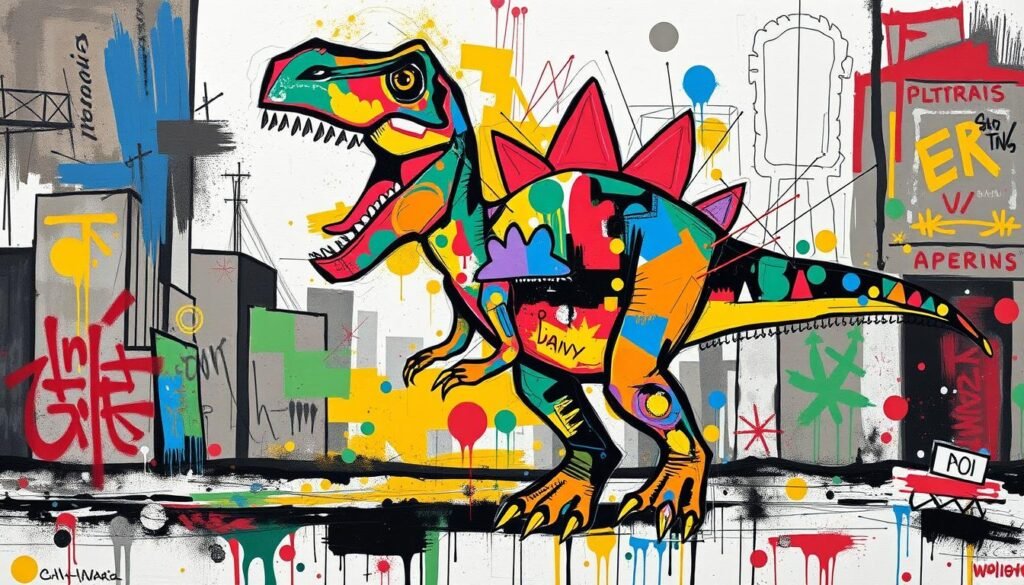Contemporary art and ancient themes offer an interesting mix, seen in the Basquiat Dinosaur. This combination captures our imagination and makes us see things differently. It’s all thanks to Jean-Michel Basquiat’s brilliant work. His art combines urban influences and dinosaurs in a unique way. It tells a powerful story for everyone who loves art and history. Basquiat’s collection includes amazing pieces. You’ll find vibrant scenes of forgotten parking lots and piles of junk with dinosaurs. He made each painting carefully in sizes like 24″x32″ and 30″x40″.
We’ll dive into Basquiat’s distinctive style, how he used Impressionistic methods, and the intriguing ideas behind his dinosaur art. His works feature billboards, overwhelming growth, and personal childhood memories of cars and dinosaurs. This makes us feel something deep. It encourages us to think about today’s world and climate change.
Key Takeaways
- Basquiat’s dinosaur art mixes contemporary and urban styles.
- His art shows an Impressionistic touch, with detailed brushstrokes and soft colors.
- The “Late Capitalism” series critiques extreme consumerism and reflects on today’s society.
- Various artists, including Basquiat, contribute to the dinosaur artwork collection.
- Many pieces depict scenes with T-Rex and other dinosaurs in unique situations.
Introduction to Jean-Michel Basquiat
Jean-Michel Basquiat became a key figure in modern art, changing urban art deeply. He brought a new style to life in the busy New York art scene of the 1980s. With a focus on art history, his work mixed African roots with pop culture. This mix gave a strong voice on social matters.
Basquiat was born on December 22, 1960, in New York. His life had many ups and downs from the start. Despite a tough beginning, art became his way to share his story. Starting with drawings sold for just $50 in 1980, his art soon captured many hearts.
In June 1980, Basquiat showed his art at the “Times Square Show.” This was his big start. By 1981, his art pieces were much sought after, each selling for about $2,500. His success brought him into the elite art circles, attending gatherings in stylish Armani suits.
Basquiat left behind 917 drawings, 25 sketchbooks, 85 prints, and 171 paintings. His art included symbols like dollar signs and dinosaurs. This became his special way to communicate. The “Boom for Real: The Late Teenage Years of Jean-Michel” documentary explores how his symbols came to be and his rise to fame, cementing his place in art history.
Understanding Basquiat’s Artistic Style
Jean-Michel Basquiat’s art is vibrant and deep. It blends graffiti and contemporary art beautifully. His work includes symbolic pictures, different marks, and a mix of visual parts.
He used crowns, skulls, and animals to show recurring themes. For example, a basquiat dinosaur in “Untitled, 1982” stands for the T-rex’s grandeur. “Snakeman” (1983) uses the dinosaur image again, showing Basquiat’s deep use of symbols.
- Symbolism: Basquiat’s symbols range from hieroglyphs in “Ishtar” (1983) to the hammer and sickle in a 1982 diptych. They reflect cultural and political stories.
- Textual Elements: His art often includes text, adding poetic and ornamental touches. A key example is “Hollywood Africans In Front Of The Chinese Theatre With Footprints Of Movie Stars” (1983).
- Cultural Commentary: Basquiat tackled social topics like race and class. He mixed humor and innocence into these serious discussions.
Basquiat mixed influences like Abstract Expressionism and street art. His unique neo-expressionist style became famous, starting with his 1981 solo exhibit. He brought a fresh perspective to the contemporary art scene with his bold use of color and abstract figures.
Basquiat’s art often highlights personal and societal stories using symbols. His use of crowns, seen in “Red Kings” (1981) and “King Alphonso” (1982-83), celebrates African American leaders. It shows respect and acknowledges their achievements.

| Symbol | Meaning | Notable Works |
|---|---|---|
| Crown | Royalty and achievement | Red Kings, Untitled (1982) |
| Dinosaur | Majesty and power | Untitled (1982), Snakeman |
| Skull | Memento mori and mortality | Untitled (1981) |
| Griot | Cultural heritage and storytelling | Grillo, Gold Griot |
Basquiat made a lasting impact with his mix of elements and themes. His work, including the basquiat art and dinosaur motif, cements him as a key figure in contemporary art.
Basquiat Dinosaur: Art Meets Prehistory
The blending of dinosaurs into the vibrant world of jean michel basquiat art creates a meaningful conversation. It connects nature, art, and what it means to be human. Dinosaurs stand out as symbols of past glory and future extinction. Basquiat’s art captures a sense of wonder and dives into deep existential themes. We’ll look at how dinosaurs play a role in his art and the unique visuals of the basquiat dinosaur theme.
Significance of Dinosaurs in Basquiat’s Work
In dinosaur art, dinosaurs catch our attention as symbols of what’s been lost. Basquiat used these ancient beasts to talk about today’s challenges. He addressed economic decay and harm to the environment. His art makes us think differently about how we interact with the world. The basquiat dinosaur criticizes how modern life affects us all.
Visual Elements of the Basquiat Dinosaur
The basquiat dinosaur is known for its bold colors and lively lines. This reflects the artist’s unique touch. The art not only displays skilled brushwork but also tells a story that moves us. Basquiat’s work merges symbols and creativity, making us think about past and present. It draws people in, showing how dinosaur art and human stories are connected.
The Fusion of Art and Prehistory
Jean-Michel Basquiat combined the basquiat dinosaur theme with his own style. This mix of modern art and ancient stories is fascinating. It makes us see history and prehistoric creatures in new ways.
Basquiat’s work is full of bright colors and bold patterns. The basquiat dinosaur is more than a subject in his art. It also symbolizes time’s flow and cultural heritage. His art makes us think about how humans and nature are connected.
Products like the Basquiat Dinosaur-Printed Men’s Socks from Urban Outfitters show his impact. The Basquiat Dinosaur Wall Art: Dinosaur King is another example. And the Graffiti Basquiat Dinosaur Sneakers highlight how his art reaches beyond galleries.
Interest in natural history is increasing. Basquiat’s focus on dinosaurs helps bridge art and ancient life. Museums display his works with dinosaur bones. This highlights how relevant these themes are today.
Exploring Contemporary and Urban Art Influences
Jean-Michel Basquiat found his inspirations in the lively New York City. This place, full of different cultures and arts, deeply affected his creativity. As a key artist in New York, Basquiat’s art included themes of fight and self. The 1980s artistic scene helped him grow, with its quick changes and cultural movements.
The Role of New York in Basquiat’s Creativity
New York’s streets were more than a backdrop for Basquiat; they fueled his art. In this city, urban art blossomed, giving artists like him a voice. Starting as a graffiti artist, he moved to galleries but kept the city’s influence. His work mixed various styles and thoughts, reflecting on race, history, and city life.
Artist Collaborations in the 1980s
Working with other artists was key to Basquiat’s success. These partnerships, especially with Andy Warhol, brought new depths to his work. Together, they delved into art and commercialism, making a big impact. His willingness to collaborate opened up new conversations in the art world.
| Aspect | Description |
|---|---|
| Influence of New York | A dynamic cultural melting pot that influenced Basquiat’s themes and style. |
| Artist Collaborations | Worked with notable figures like Andy Warhol for unique art ventures. |
| Legacy | Basquiat left behind a profound impact through his art, shaping the urban art movement. |
| Artistic Expression | Explored varied themes, addressing social issues and personal identity through urban experiences. |
For more about Basquiat’s life and art, check out his artist profile. His story shows the power of urban art and the benefits of artists working together in the modern art scene.
Art Galleries Showcasing Basquiat’s Dinosaur Artwork
Many art galleries highlight Basquiat’s dinosaur art, showing its impact on today’s culture. They are located throughout the U.S., spotlighting how Basquiat mixes his vision with social themes. These places help people appreciate his art and the stories they tell.
The Lucky Cat Gallery is a prime spot. It has the Jean-Michel Basquiat PEZ Dispenser (LED Neon Wall Art) for $309.00. The artwork is 19.7 inches tall, 15.75 inches wide, and just 0.2 inches deep. Made in 2024, it is one of seven unique neon pieces in the “Art Is A Voice” Collection. It features Basquiat’s famous crown on a dinosaur, blending his roots with pop culture.

Various galleries also showcase Basquiat’s dinosaur themes. They boost interest in urban and modern art. These places make his art more known. Visitors see the beauty and learn about Basquiat’s influences, his background, and his work with Andy Warhol.
By showing his works, galleries lift the status of Basquiat’s dinosaur art. They make sure new generations can see and value the complex stories in his pieces. As urban art grows, dinosaur art in Basquiat’s collection remains a fascinating way to see his ideas and current art trends.
The Cultural Impact of the Basquiat Dinosaur
The basquiat dinosaur brings together history and art in a special way. This creates a big impact on today’s art scene. Basquiat’s use of bold colors and symbols invites us to think about our roots and who we are.
His famous “Pez Dispenser” shows a dinosaur with a crown. This piece talks about power and importance using old and new ideas. It starts conversations about society and power. The issue with selling Basquiat’s work, like in the Tiffany & Co. ad “Equals Pi”, shows us the conflict between making money and staying true to one’s beliefs.
Basquiat fought against wrongly using black excellence. He aimed to make things better for black people while remembering their history. The crown he often painted is a sign of hope and speaking for oneself. It helps people today connect with deep and timeless messages.
Basquiat mixed many influences in his art, connecting history with the now. His way of combining graphic icons with expressive painting shows deep historical insight. He encourages us to value and celebrate different cultures through his art.
| Artwork | Year | Cultural Significance |
|---|---|---|
| Pez Dispenser | 1984 | Symbolizes power and authority |
| Equals Pi | 1982 | Highlights commercialization issues in the art world |
| Untitled | 1981 | Record-breaking sale reflecting enduring legacy |
Basquiat’s knack for blending different influences shows his artistic brilliance. His art inspires people all over the world, making the basquiat dinosaur an important topic in art and culture talks.
Conclusion
Jean-Michel Basquiat’s work, like the basquiat dinosaur motif, shows he was a groundbreaking artist. He mixed dinosaurs into his art, showing his creative spirit. This made people think about history and today’s world in a new way.
Basquiat’s art, with its dinosaurs, keeps inspiring artists today. His use of vibrant colors and bold shapes brought new life to art. It shows that art can connect the past and present, creating ongoing conversations.
Basquiat’s influence is clear and lasting. His dinosaur art gets love and praise, underlining his brilliance. It reminds us how mixing history with street culture has shaped modern art forever.





